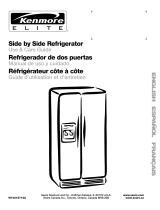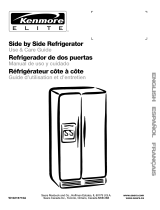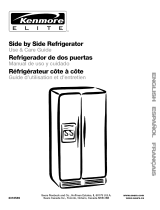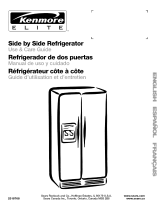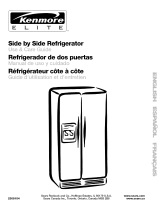
5
Remove the Doors
1. Unplug refrigerator or disconnect power.
2. Open both doors (refrigerator and freezer) and the water filter
cover door. It is not necessary to remove the water filter itself.
3. Remove the base grille by pulling up on the bottom outside
corners. See Graphic 1.
4. Disconnect the water dispenser tubing located behind the
base grille on the freezer door side. The dispenser tubing runs
through the door hinge, and must be disconnected in order to
remove the door. See Graphic 2.
■ Press blue outer ring against the face of fitting and pull the
dispenser tubing free.
NOTE: Keep the water tubing connector attached to the
tube that runs underneath the freezer. The door cannot be
removed if the connector is still attached to the tube that
runs through the door hinge.
5. Disconnect the wiring located behind the base grille on the
freezer door side. See Graphic 3.
■ Remove the wiring clip using a ¹⁄₄" hex-head socket
wrench.
■ Disconnect wiring plugs.
6. Close both doors and keep them closed until you are ready to
lift them free from the cabinet.
7. Use a ⁵⁄₁₆" hex-head socket wrench to remove the top left
hinge as shown. See Graphic 4.
IMPORTANT: Do not remove either screw A.
8. Lift freezer door straight up off bottom hinge. See Graphic 5.
The water dispenser tubing and wiring remain attached to the
freezer door and pull through the bottom left hinge.
NOTE: This may require two people - one to lift the door and
another to feed the water tubing and wiring through the hinge.
IMPORTANT: Rest the door on its side on a soft, clean
surface, such as a towel, blanket or piece of cardboard. This
will help avoid damaging the door, water tubing and wiring.
9. Remove top right hinge as shown. See Graphic 6.
IMPORTANT: Do not remove either screw A.
10. Lift the refrigerator door straight up off bottom hinge.
IMPORTANT: Rest the door on its side on a soft, clean
surface, such as a towel, blanket or piece of cardboard. This
will help avoid damaging the door.
11. It may not be necessary to remove the bottom hinges to move
the refrigerator through a doorway. Both bottom hinges have
similar construction.
■ If necessary, disassemble the hinges as shown. See
Graphic 7.
IMPORTANT: To aid in door alignment and closing, there
is a shim located between the hinge and the cabinet.
When the hinge is removed, the shim may fall out of
place. If this occurs, set the shim aside so it can be put
back in place when the hinge is reconnected later.
Replace the Doors and Hinges
1. Replace both bottom hinges, if removed. Make sure the shim
is between the hinge and cabinet. Tighten screws.
2. Before replacing the freezer door on the bottom left hinge,
feed the wiring with the yellow plug and the water dispenser
tubing through the hinge. Assistance may be needed.
NOTE: Provide additional support for the doors while the top
hinges are being replaced. Do not depend on the door magnets to
hold the doors in place while you are working.
3. Align and replace the top left hinge as shown. See Graphic 4.
Tighten screws.
4. Reconnect water dispenser tubing and wiring.
IMPORTANT: Do not intertwine the water tubing and wiring
bundles when reconnecting them.
■ Push tubing into fitting until it stops and the black mark
touches the face of fitting. See Graphic 2.
■ Reconnect wiring plugs. Reinstall the wiring clip over the
grommets. Tighten screw. See Graphic 3.
5. Replace the refrigerator door by lifting the door onto the
bottom right hinge.
6. Align and replace the top right hinge as shown. See Graphic 6.
Tighten screws.
7. Replace the ice storage bin (on some models) and any
adjustable door or utility bins.
8. Plug into a grounded 3 prong outlet.
Leveling and Door Closing
Your refrigerator has two front adjustable rollers — one on the
right and one on the left. If your refrigerator seems unsteady or if
you want the doors to close more easily, adjust the refrigerator's
tilt using the instructions below:
1. Move the refrigerator into its final location.
2. Remove the base grille to locate the two leveling screws,
which are part of the front roller assemblies on each side.
See Graphic 8.
NOTE: Having someone push against the top of the refrigerator
takes some weight off the leveling screws and rollers. This makes
it easier to adjust the screws.
3. Use a ¹⁄₂" hex-head socket wrench to adjust the leveling
screws. Turn the leveling screw to the right to raise that side of
the refrigerator or turn the leveling screw to the left to lower
that side. It may take several turns of the leveling screws to
adjust the tilt of the refrigerator. See Graphic 8.
4. Open both doors again and check that they close as easily as
you like. If not, tilt the refrigerator slightly more to the rear by
turning both leveling screws to the right. It may take several
more turns, and you should turn both leveling screws the
same amount.
5. Use a bubble level to check the leveling of the refrigerator.
NOTE: Whenever you need to move the refrigerator, turn the
leveling feet to the right until they are no longer touching the
ground. This will allow the refrigerator to roll more easily.
Door Alignment
A refrigerator that is not level from side-to-side may appear to
have doors that are not properly aligned. If the doors appear this
way, use the instructions in the previous section to check the
leveling.
The doors are designed to be slightly different heights when the
refrigerator is empty, in order to account for the weight of food
that will be placed on the doors. If the doors are still not aligned
after checking the leveling and loading the refrigerator with food,
follow the steps below to adjust the door alignment.
WARNING
Electrical Shock Hazard
Disconnect power before removing doors.
Failure to do so can result in death or electrical shock.
















